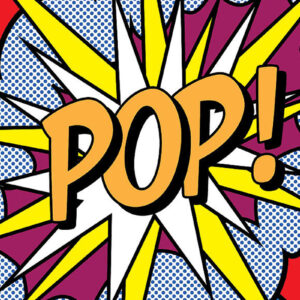
Pop Art Graphic Designing And How Brands Are Using It
Pop art, perhaps the most notable artistic revolution of the 20th century, seamlessly merged culture and creativity. Rooted in industrialism and mass media, this movement reshaped perceptions of art and consumerism. From its inception in the 1950s to becoming a cultural cornerstone in the ’60s, pop art defied traditional artistic norms and embraced the ordinary, turning mundane items into extraordinary visual experiences. All things considered, it drew upon regular articles and media like papers, comic books, magazines. And other unremarkable items to create dynamic structures. Building up the development as a foundation of contemporary art. What Makes Pop Art Stand Out? Pop art broke away from abstract expressionism, replacing introspective forms with vibrant depictions of everyday objects. Artists like Andy Warhol and Roy Lichtenstein (more about them later) redefined what art could be, using techniques like silkscreen printing and lithography to mass-produce works that were both relatable and revolutionary. These characteristics make pop art instantly recognizable and universally appealing. Defining Pop Art Graphic Designing Pop art is a development that arose during the twentieth century wherein artists fused ordinary articles. Funny cartoons, soup jars, papers, and that’s just the beginning—into their work. The Pop art development meant to cement the possibility that art can draw from any source, and there is no progression of culture to disturb this. At its core, pop art celebrates ordinary objects and mass media, transforming them into visually striking compositions. It blends humor, satire, and irony, often commenting on consumer culture or societal trends. Pop art is effectively unmistakable because of its energy and remarkable attributes. That are available in large numbers of the most famous works of the development. Characteristics like vibrant colors, bold imagery, and creative techniques define its aesthetic. Characteristics and qualities of Pop art Graphic Designing : Conspicuous symbolism: Pop art used pictures and symbols from popular media and items. This included everyday items like soup jars, street signs, and photographs of superstars. Indeed, even brand names and logos fused. Brilliant tones: Pop art is described by lively, splendid tones. Bright primary hues dominate, creating eye-catching designs. Essential tones like red, yellow, and blue were noticeable colors that showed up in numerous popular works. Particularly in Roy Lichtenstein’s assortment of work. Incongruity and parody: Humor was one of the fundamental segments of Pop art. Social commentary often masked in playful visuals. Artists utilize the topic to say something about recent developments, make fun of crazes, and stir things up. innovative Techniques: Many Pop artists occupied with printmaking measures, which empowered them to rapidly repeat pictures in enormous amounts. Andy Warhol utilized silkscreen printing and interaction through which ink moved onto paper. Or material through a lattice screen with a stencil. Roy Lichtenstein utilized lithography, or printing from a metal plate or stone, to accomplish his unique visual style. Pop artists regularly took symbolism from different spaces of standard culture. And joined it into their artworks, either modified or in their unique structure. This kind of appropriation art regularly worked inseparably with reiteration. To separate the partition between high art and low art, which made the qualification among publicizing and media from compelling artwork. Since the time pop art arose in the fifties, it has been going connected at the hip with the design business. Defying elitist esteems and self-reflexive expressionist development, pop art accepted commonplace living encounters. Presenting parts of mass culture and carrying art nearer to the new age of Americans who were starting to encounter all advantages. Of the purchaser heaven in the government assistance condition of post-war America. Pop art utilized natural mass culture symbolism from notices to other trite articles. Wrapping it into exciting and striking shading blends. How Pop Art Graphic Designing Shaped the Fashion Industry The collaboration between pop art and fashion began in the 1960s, redefining both industries. Pop art introduced a new dimension to fashion, where vibrant prints and bold graphics became a statement. These designs appealed to mass audiences, making art accessible beyond gallery walls. Andy Warhol and the Paper Dress Craze Andy Warhol is likely the main significant pop art symbol to turn into a powerful figure in the design world. He started his profession as a style artist, working for magazines like Glamour, Mademoiselle, and even Vogue. He was additionally one of the initial artists to transform his art into design things. Very much like pop art was turning towards mass culture in the fifties and sixties. High style as the thing of elites tested once the design business with mass-delivered things entered the scene. During the sixties, Warhol started to print his art plans on paper dresses, which were at the time turning into an oddity. These pieces of clothing caught the actual quintessence of the consumerist way of life. As they handled the possibility of the superfluity of purchaser merchandise. Likely the most conspicuous paper dress from the sixties was the Souper Dress, the one including Warhol’s Campbell’s Soup Cans print. Despite the fact that they were select at the time, they seemed to have quickly built up an entire line. Of these items, making Souper Dresses accessible to anybody is two or three dollars. During the sixties, pop art-roused paper dresses turned into the standard article of clothing, commencing a rage in the style world. And even now, when they have totally vanished from the market, they keep on motivating contemporary style planners. Marriage between Pop Art Graphic Designing and Fashion Design The business partnership among art and style configuration is the same old thing to us. As each and every year we see art-roused assortments on the catwalks around the world. In any case, on account of its inclination established in the festival of consumerist merchandise. Energetic and appealing examples and the capacity to communicate in the all-inclusive language. Liberated from artistic work elitism, pop art was bound to turn into the most alluded art development in the style business. This marriage between pop art and the style industry started to create in the




















